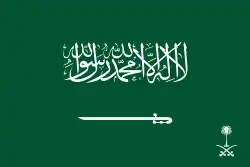Prime Minister of Saudi Arabia
The Prime Minister of Saudi Arabia (Arabic: رئيس مجلس الوزراء, romanized: raʾīs majlis al-wuzaraʾ) is the chairman of the Council of Ministers and head of government of the Kingdom of Saudi Arabia. Mohammed bin Salman has been Prime Minister since 27 September 2022.[1]
| Prime Minister of Saudi Arabia | |
|---|---|
| رئيس وزراء المملكة العربية السعودية | |
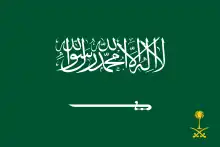 | |
| Incumbent | |
.jpg.webp) | |
| Mohammed bin Salman since 27 September 2022 | |
| Details | |
| Style | Custodian of the Two Holy Mosques (Formal) Your Majesty (Diplomatic) |
| Formation | 23 September 1932 |
| Residence | Al-Yamamah Palace (Riyadh) Al-Salam Palace (Jeddah) |
.svg.png.webp) |
|---|
|
|
| Basic Law |
|
|
History
The office was created along with the Council of Ministers on 9 October 1953, by decree of King Saud. Due to unrest within the royal family over his rule, Saud was forced to appoint his half-brother, Crown Prince Faisal, as prime minister. An ongoing power struggle between the two led to Faisal's resignation in 1960, allowing Saud to reclaim the reins of government, but continued discontent saw Faisal return as prime minister in 1962. After the deposition of Saud in 1964, Faisal succeeded him as king, while remaining prime minister. From that point until the appointment of Mohammed bin Salman as prime minister by King Salman, the two offices were merged.[2] Since the reign of King Khalid, others have done much of the "heavy lifting" as the king was either unwilling or unable to carry the workload, especially as the kingdom became a gerontocracy during the 1990s and 2000s. Royal favorites achieved power to become de facto prime ministers. The current one is the King's son Mohammad, who is his father's top aide.
List of Prime Ministers of Saudi Arabia
| No. | Portrait | Name (Birth–Death) |
Time in office | Notes | ||
|---|---|---|---|---|---|---|
| Took office | Left office | Days in office | ||||
| 1 | 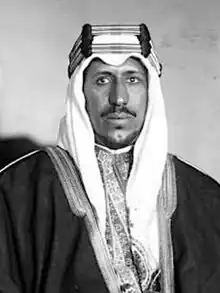 |
Saud (1902 – 1969) King 1953 – 1964 | 9 October 1953 | 16 August 1954[3] | 311 | Saud created the post of Prime Minister for himself, and appointed Crown Prince Faisal Prime Minister in 1954. The two would engage in a power struggle which would ultimately lead to Saud's abdication of the throne and exile. |
| 2 | 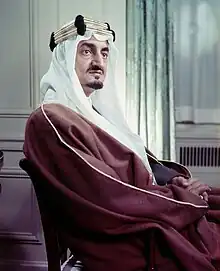 |
Faisal (1906 – 1975) | 16 August 1954 | 21 December 1960 | 2319 | First Prime Minister who was not the King at time of appointment. |
| 1 |  |
Saud (1902 – 1969) King 1953 – 1964 | 21 December 1960 | 31 October 1962 | 679 | Second tenure. Saud lost a power struggle to Crown Prince Faisal and was forced to abdicate in 1964. |
| 2 |  |
Faisal (1906 – 1975) King 1964 – 1975 | 31 October 1962 | 25 March 1975 | 4528 | Second tenure. Faisal became King on 2 November 1964 and was assassinated on 25 March 1975. |
| 3 | 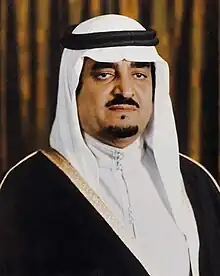 |
Fahd (1920, 1921 or 1923 – 2005) King 1982 – 2005 | 25 March 1975 | 21 February 1996 | 7638 | De facto Prime Minister during Khalid's reign (1975–1982) and through his own until suffering a stroke in 1996. Second Prime Minister who was not the King at the time of his appointment. |
| 4 |  |
Abdullah (1924 – 2015) King 2005 – 2015 | 21 February 1996 | 23 January 2015 | 6911 | De facto Prime Minister after Fahd's stroke in 1996, de jure from 9 October 2005 to 23 January 2015. Some regard Khaled al-Tuwaijri as a de facto Prime Minister from 9 October 2005 to 23 January 2015. |
| 5 | _(cropped).jpg.webp) |
Salman (born 1935) King 2015 – | 23 January 2015 | 27 September 2022 | 2742 | Most day-to-day governance was handled by the King's son Mohammed bin Salman. |
| 6 |  |
Mohammed bin Salman (born 1985) | 27 September 2022 | Incumbent | 394 | Chief of the Royal Court, chair of the Council for Economic and Development Affair and Minister of Defense under King Salman |
See also
References
- "Saudi Arabia's Crown Prince to become Kingdom's Prime Minister: Royal decree". Al Arabiya English. Retrieved 2022-09-27.
- أرشيف-شاهد على العصر-الأمير طلال بن عبد العزيز ج1 [Watch the Times – Prince Talal bin Abdul Aziz] (in Arabic). Al Jazeera. 31 July 2016. Archived from the original on 2021-12-21 – via YouTube.
-
- "Saudi Arabia". WorldStatesman. Ben Cahoon. Retrieved 2014-03-31.

